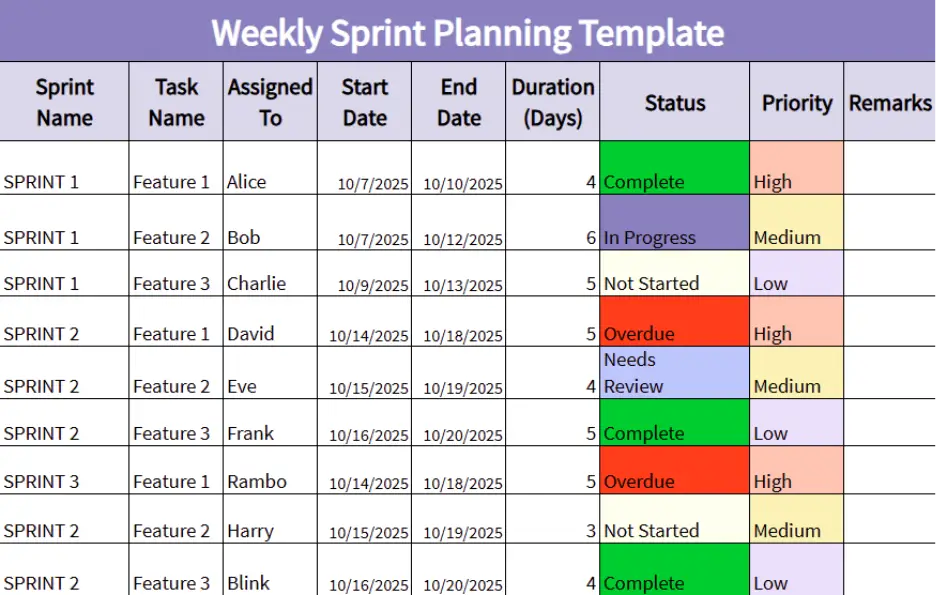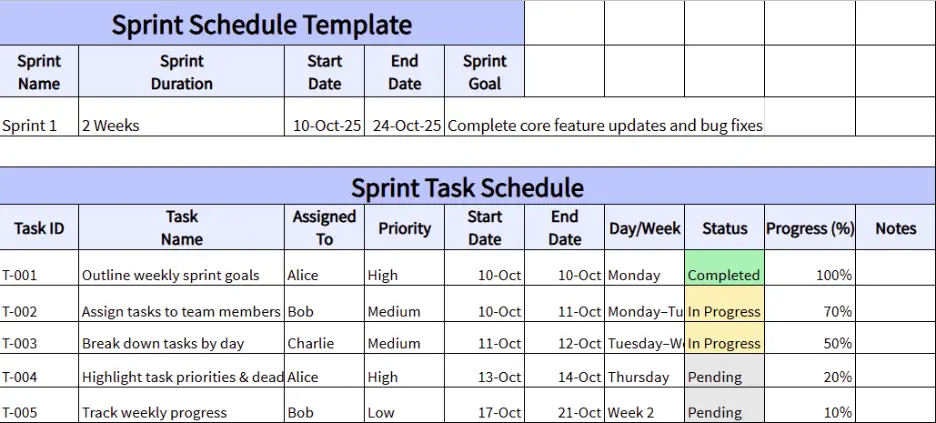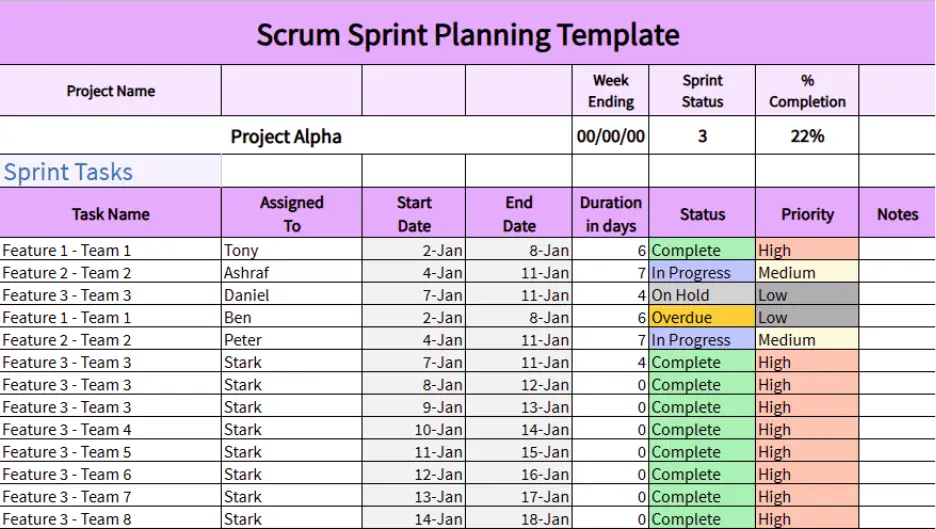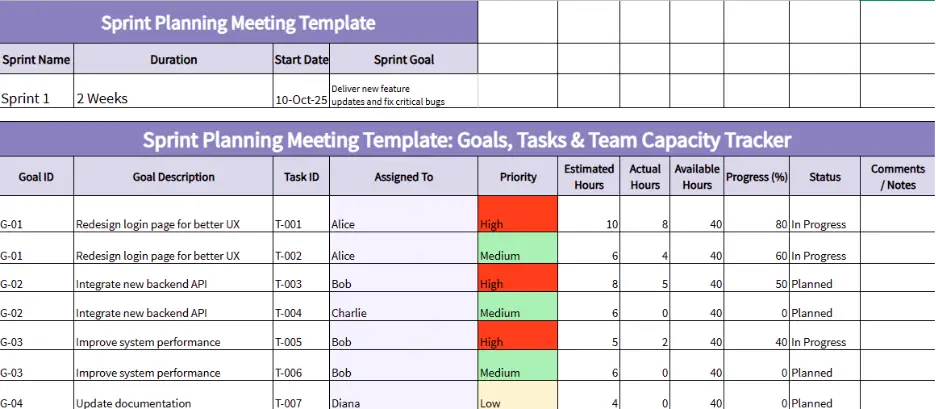Keeping a team aligned and projects on track during sprint planning can be challenging. Missed deadlines, disorganised tasks, and mismatched priorities can slow down your business productivity. The right sprint planning templates make it easier to plan and offer a structure and assist you in managing tasks efficiently.
This guide includes 7 free templates of sprint plans in PDF, Excel, and Word formats. No matter which workflow your team is using, whether Agile, Scrum, or a more traditional one, these sprint planning templates will assist you in scheduling, tracking, and monitoring progress. Having clear visuals, well-organised layouts, and custom colours that are aligned with your brand makes the sprint handling quick and seamless.
What are the 7 Types of Sprint Planning Templates?
All teams handle sprint planning in their own way, and it is necessary to select the appropriate template. Here are 7 types of sprint planning templates that can be used to accomplish various tasks, from basic task breakdowns to elaborate Agile and Scrum models.
1. Sprint Planning Template
This template is designed to give you a clear roadmap for each sprint. It assists you in establishing sprint objectives, assigning the work, and monitoring performance according to timeframes. Through this sprint planning template, your teams can prevent confusion, minimise bottlenecks, and make everyone focused on the sprint goals.

Key Features:
- Defines Sprint Goals: Enables you to clear objectives for the sprint to guide the team’s focus.
- Breaks Down Tasks: Allows you to organise work into manageable tasks for easy tracking and assignment.
- Assigns Responsibilities: Clarifies task ownership to ensure accountability and avoid confusion.
- Provides Sprint Timeline Overview: Shows start/end dates, milestones, and deadlines for effective planning.
- Tracks Progress: Gives a high-level view of tasks completed, in progress, or pending for the entire sprint.
Best For:
Teams that want to remain focused and organised during the sprint cycles, ensuring the team members understand what to deliver and when.
2. Weekly Sprint Planning Template
The weekly sprint planning template helps you plan on a weekly basis based on the tasks and priorities in the sprint. It divides the sprint cycle into smaller, manageable tasks and allows tracking the progress and reviewing the workloads, as well as making rapid changes. It works well with teams that require frequent check-ins to ensure everything is on track and things are operating smoothly.

Key Features:
- Outlines Weekly Sprint Goals: Provides a clear view of what needs to be achieved within the week
- Assigns Tasks to Team Members: Ensures accountability and clarity on responsibilities
- Breaks Down Tasks by day: Helps teams focus on daily priorities and manage workloads effectively
- Highlights Task Priorities and Deadlines: Ensures critical tasks are completed on time
- Tracks Weekly Task Progress: Shows task completion and priorities for the current week to keep the team on track.
Best For:
Teams that need formal weekly checkpoints to keep themselves accountable, track progress, and adapt rapidly to evolving needs.
3. Sprint Schedule Template
These templates assist you in scheduling and structuring the timeline of your sprint, including tasks, deadlines, and team responsibilities. They simplify the process of monitoring progress, handling workloads, and ensuring that sprint objectives are achieved within the allocated time. These templates ensure that the teams are on track, enhance collaboration, and help you complete all the tasks without any delay.

Key Features:
- Sprint Timeline Overview: Provides start and end dates, milestones, and overall sprint duration.
- Task Assignments: Ensures clear allocation of tasks to individual team members.
- Daily/Weekly Task Breakdown: Helps teams focus on what needs to be done each day or week
- Task Priorities and Deadlines: Helps to assign tasks based on priority, deadlines, and complete critical tasks on time.
- Team Workload Visibility: Highlights task distribution, identifies overloads, and helps balance work for smoother sprints.
Best For:
Scrum masters and project managers who manage programs with multiple tasks and team members with effective visibility of progress, responsibilities, and deadlines.
4. Agile Sprint Planning Template
This template is specifically designed for Agile teams to plan and implement sprints. It works on organising backlogs, prioritisation of tasks, allocation of work to appropriate team members, and monitoring iterative progress. With this template, you can ensure transparency and better collaboration.

Key Features:
- Defines Sprint Objectives: Sets clear goals derived from the product backlog to guide the team’s focus throughout the sprint.
- Prioritises Backlog Items: Organises tasks according to business value and urgency to maximise sprint output.
- Assigns Tasks to Team Members: Clarifies ownership to maintain accountability and prevent overlaps.
- Monitors Iterative Progress: Uses visual indicators like To Do, In Progress, and Done to track task completion and identify blockers in real time.
Best For:
Agile teams, scrum masters, and product owners who require a structured plan on how to plan sprints, prioritise high-value tasks, adapt fast to changes, and keep the teams aligned.
5. Scrum Sprint Planning Template
This template is specifically created to help Scrum teams plan sprints within the Scrum framework. It assists you in defining sprint goals, refining product backlog, assigning tasks to team members, and progress monitoring throughout the sprint. This template helps your team stay focused, follow Scrum practices consistently, and deliver valuable work efficiently.

Key Features:
- Refines Sprint Backlog: Helps you prioritise and break down backlog items into actionable tasks for the sprint.
- Defines Sprint Goals: Provides a framework to set clear objectives for the sprint to align the team with Scrum commitments.
- Allocates Tasks by Scrum Roles: Allows you to assign work to developers, testers, and other team members to ensure accountability.
- Supports Scrum Meetings: Offers structure for sprint planning, daily stand-ups, and sprint reviews to maintain workflow and transparency.
- Tracks Sprint Velocity: Gives visibility into completed story points (a measure of task complexity and effort), helping teams plan future sprints more accurately.
Best For:
Scrum teams, Scrum masters, and Product owners who desire to plan sprints using the Scrum framework, backlog priorities, and monitor progress using velocity and team commitments.
6. Sprint Planning Meeting Template
This template assists you in streamlining sprint discussions by giving you a structured area to establish goals, define priorities, and allocate tasks efficiently. It makes sure you and your team are aware of what to deliver and how it relates to sprint goals. This template will help you manage your time, maintain a clear communication channel, and identify possible challenges in advance so that your sprint begins with a solid foundation and remains on schedule.

Key Features:
- Defines Sprint Goals: Helps teams agree on clear, measurable objectives for the sprint.
- Allocates Tasks Efficiently: Supports workload division based on skill sets and availability.
- Tracks Meeting Notes: Captures key points, decisions, and follow-up actions for accountability.
- Sets realistic Sprint Capacity: Aligns workload with team velocity and available resources.
- Improves Team Alignment: Encourages collaboration and shared understanding before execution begins
Best For:
Teams that require formal sprint planning sessions to establish the objectives, delegate tasks, and synchronise everyone before the sprint begins.
7. Project Sprint Planning Template
The project sprint planning template will assist you in planning large projects into small, manageable sprints. It helps to maintain all the phases aligned with the large-scale project goals, prioritises the tasks, and meets deadlines. This template is ideal when working on a long-term or cross-functional project that needs a definite schedule and tracking of progress.

Key Features:
- Breaks Down Complex Projects: Divides large projects into focused sprint cycles for easier tracking and execution.
- Aligns Sprint Goals with /Project Milestones: Ensures every sprint contributes to the overall project objectives.
- Assigns Roles and Responsibilities: Clarifies ownership to maintain accountability across team members.
- Monitors Project Progress: Provides a high-level overview of sprint completion and pending tasks.
- Improves Cross-Team Collaboration: Keeps communication open between departments to avoid delays and overlap.
Best For:
Project managers and cross-functional groups dealing with huge projects, aligning sprints, assigning tasks and responsibilities, and tracking progress easily.
What Are the Pros and Cons of Sprint Planning Template?
Sprint planning templates are essential resources in ensuring that teams remain focused and organised in sprints. These templates provide clear benefits along with some drawbacks. Here’s a quick look at the pros and cons of using these templates:
| Pros | Cons |
|---|---|
| Provides a clear roadmap for each sprint | Time-consuming to set up initially |
| Helps assign tasks and clarify responsibilities | May require frequent updates if priorities change |
| Improves team alignment and focus | Not suitable for teams with highly unpredictable workloads |
| Tracks progress visually for accountability | Can be complex for very small teams with few tasks |
| Supports goal-oriented sprint execution | Over-reliance may reduce flexibility for spontaneous changes |
How Can Time Champ Improve Sprint Planning
Time Champ helps teams in planning sprints more effectively by providing a centralised platform to view tasks, deadlines, and progress in real time. You can easily assign tasks, set priorities, and track task completion, instead of relying on multiple spreadsheets or notes to do the same. This prevents confusion, enhances project effectiveness, and ensures that everyone understands what they need to concentrate on during the sprint.
Additionally, the analytics and reporting features of Time Champ provide insights into team performance, which allows you to modify workloads and maximise the efficiency of future sprints. It also simplifies the process of communication, helps to maintain the team focused, and saves time in sprint planning.
Conclusion
Effective sprint planning is important in maintaining productive teams and keeping projects on schedule. The right sprint planning template gives a structure, clarity, and a clear road map of tasks, priorities, and deadlines. They help keep the teams on track and focused during the sprint.
Whether you’re managing a small team or leading large teams made up of multiple departments, these templates will help you make smoother sprints, smarter task control, and a better roadmap to reach your project goals.
Frequently Asked Questions
A sprint planning template must have the sprint goals, task lists, team assignments, timelines, priorities, and progress tracking sections to make all the tasks organised and visible to all the concerned employees.
Select a template depending on the objectives and tasks of your team. As an example, iterative teams should use an Agile or Scrum template, whereas long-term or cross-functional projects should use project sprint templates.
Yes, every template of Excel, Word, and PDF can be personalised. There are options to edit colours, incorporate your company branding, change layouts, or even adjust sections of the tasks to suit your project.
Agile sprint planning templates rely on the flexible and iterative management of tasks, whereas Scrum templates are more structured and contain the roles, meetings, and backlog refinement in accordance with the Scrum framework.
Yes! Sprint planning templates can help even small teams to structure work, prevent duplication, and keep focus, particularly when there are several short-term tasks. These templates enable small teams to stay on track and meet deadlines at all times.






